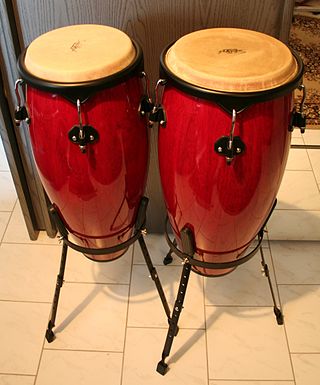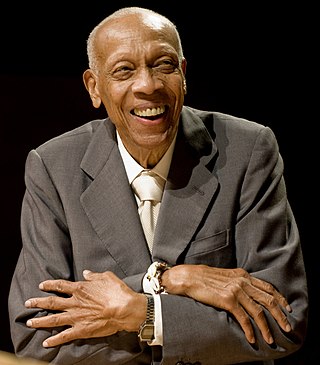Mambo is a genre of Cuban dance music pioneered by the charanga Arcaño y sus Maravillas in the late 1930s and later popularized in the big band style by Pérez Prado. It originated as a syncopated form of the danzón, known as danzón-mambo, with a final, improvised section, which incorporated the guajeos typical of son cubano. These guajeos became the essence of the genre when it was played by big bands, which did not perform the traditional sections of the danzón and instead leaned towards swing and jazz. By the late 1940s and early 1950s, mambo had become a "dance craze" in Mexico and the United States as its associated dance took over the East Coast thanks to Pérez Prado, Tito Puente, Tito Rodríguez and others. In the mid-1950s, a slower ballroom style, also derived from the danzón, cha-cha-cha, replaced mambo as the most popular dance genre in North America. Nonetheless, mambo continued to enjoy some degree of popularity into the 1960s and new derivative styles appeared, such as dengue; by the 1970s it had been largely incorporated into salsa.

Salsa music is a style of Caribbean music, combining elements of Cuban, Puerto Rican, and American influences. Because most of the basic musical components predate the labeling of salsa, there have been many controversies regarding its origin. Most songs considered as salsa are primarily based on son montuno and son Cubano, with elements of cha-cha-chá, bolero, rumba, mambo, jazz, R&B, rock, bomba, and plena. All of these elements are adapted to fit the basic Son montuno template when performed within the context of salsa.
The music of Cuba, including its instruments, performance, and dance, comprises a large set of unique traditions influenced mostly by west African and European music. Due to the syncretic nature of most of its genres, Cuban music is often considered one of the richest and most influential regional music in the world. For instance, the son cubano merges an adapted Spanish guitar (tres), melody, harmony, and lyrical traditions with Afro-Cuban percussion and rhythms. Almost nothing remains of the original native traditions, since the native population was exterminated in the 16th century.

Bartolomé Maximiliano Moré Gutiérrez, better known as Benny Moré, was a Cuban singer, bandleader and songwriter. Due to his fluid tenor voice and his great expressivity, he was known variously as "El Bárbaro del Ritmo" and "El Sonero Mayor". Moré was a master of the soneo – the art of vocal improvisation in son cubano – and many of his tunes developed this way. He often took part in controversias with other singers, including Cheo Marquetti and Joseíto Fernández. Apart from son cubano, Moré was a popular singer of guarachas, cha cha cha, mambo, son montuno, and boleros.
Rhumba, also known as ballroom rumba, is a genre of ballroom music and dance that appeared in the East Coast of the United States during the 1930s. It combined American big band music with Afro-Cuban rhythms, primarily the son cubano, but also conga and rumba. Although taking its name from the latter, ballroom rumba differs completely from Cuban rumba in both its music and its dance. Hence, authors prefer the Americanized spelling of the word (rhumba) to distinguish between them.
Danzón is the official musical genre and dance of Cuba. It is also an active musical form in Mexico and Puerto Rico. Written in 2
4 time, the danzón is a slow, formal partner dance, requiring set footwork around syncopated beats, and incorporating elegant pauses while the couples stand listening to virtuoso instrumental passages, as characteristically played by a charanga or típica ensemble.
Son cubano is a genre of music and dance that originated in the highlands of eastern Cuba during the late 19th century. It is a syncretic genre that blends elements of Spanish and African origin. Among its fundamental Hispanic components are the vocal style, lyrical metre and the primacy of the tres, derived from the Spanish guitar. On the other hand, its characteristic clave rhythm, call and response structure and percussion section are all rooted in traditions of Bantu origin.
A descarga is an improvised jam session consisting of variations on Cuban music themes, primarily son montuno, but also guajira, bolero, guaracha and rumba. The genre is strongly influenced by jazz and it was developed in Havana during the 1950s. Important figures in the emergence of the genre were Cachao, Julio Gutiérrez, Bebo Valdés, Peruchín and Niño Rivera in Cuba, and Tito Puente, Machito and Mario Bauzá in New York. Originally, descargas were promoted by record companies such as Panart, Maype and Gema under the label Cuban jam sessions. From the 1960s, the descarga format was usually adapted by large salsa ensembles, most notably the Fania All-Stars.

Dionisio Ramón Emilio Valdés Amaro, better known as Bebo Valdés, was a Cuban pianist, bandleader, composer and arranger. He was a central figure in the golden age of Cuban music, especially due to his big band arrangements and compositions of mambo, chachachá and batanga, a genre he created in 1952.

Israel López Valdés, better known as Cachao, was a Cuban double bassist and composer. Cachao is widely known as the co-creator of the mambo and a master of the descarga. Throughout his career he also performed and recorded in a variety of music styles ranging from classical music to salsa. An exile in the United States since the 1960s, he only achieved international fame following a career revival in the 1990s.
Cha-cha-chá is a genre of Cuban music. It has been a popular dance music which developed from the Danzón-mambo in the early 1950s, and became widely popular throughout the world.

Michel Elefteriades is a Lebanese politician, artist, producer and entrepreneur. He is noted in the Arab world for his unorthodox beliefs and opinions, which have generated controversy and ignited passionate responses from his supporters and detractors alike.
Orestes López Valdés, nicknamed Macho, was a Cuban multi-instrumentalist, composer and bandleader. As a double bassist he was a founding member of the Havana Philharmonic Orchestra, and later a member of the National Symphony Orchestra of Cuba. A long-time member of the charanga Arcaño y sus Maravillas, where he played cello and piano, he is considered the co-creator of the mambo, together with his brother Israel "Cachao" López, and one of the most prolific danzón composers of the 20th century.
Cuban folk music includes a variety of traditional folk music of Cuba, and has been influenced by the Spanish and the African culture as well as the remaining indigenous population of the Caribbean.
Tropical music is a term in the Latin music industry that refers to music genres deriving from or influenced by the Spanish-speaking areas of the Caribbean. It includes the islands of Cuba, Puerto Rico, the Dominican Republic, and the Caribbean coastal regions of Colombia, Mexico, Central America and Venezuela.

Ernest AnthonyPuente Jr., commonly known as TitoPuente, was an American musician, songwriter, bandleader, timbalero, and record producer. He composed dance-oriented mambo and Latin jazz music.

Cuban culture encompasses a wide range of dance forms. The island's indigenous people performed rituals known as areíto, which included dancing, although little information is known about such ceremonies. After the colonization of Cuba by the Spanish Kingdom, European dance forms were introduced such as the French contredanse, which gave rise to the Cuban contradanza. Contradanza itself spawned a series of ballroom dances between the 19th and 20th centuries, including the danzón, mambo and cha-cha-cha. Rural dances of European origin, such as the zapateo and styles associated with punto guajiro also became established by the 19th century, and in the 20th century son became very popular. In addition, numerous dance traditions were brought by black slaves from West Africa and the Congo basin, giving rise to religious dances such as Santería, yuka and abakuá, as well as secular forms such as rumba. Many of these dance elements from European dance and religious dances were fused together to form the basis of la técnica cubana. Cuban music also contributed to the emergence of Latin dance styles in the United States, namely rhumba and salsa.
Francisco Fellove Valdés, also known as El Gran Fellove, was a Cuban songwriter and singer. A prolific composer of the feeling generation, he is well known for his particular style of scat singing known as chua chua. He is the author of the famous guaracha-pregón "Mango mangüé", recorded by Machito and Celia Cruz among others. He was the cousin of conga drummer Carlos "Patato" Valdés.

"Chanchullo" is a danzón-mambo composed by Cuban bassist Israel "Cachao" López. It was first released as a single in 1957 by Arcaño y sus Maravillas. It was the third single released on Cuban independent record label Gema and has been covered by multiple artists including Tito Puente, Típica '73 and Rubén González. Puente himself reworked the song as the successful "Oye cómo va", later recorded by Santana, for which Cachao received no credit. Instrumental versions of the song have been recorded variously under the titles "Mambolandia" and "Mambología", often credited to Peruchín.
Khalil Chahine is a German-Lebanese audio engineer, mixer, and music producer. Originally from Beirut, he has worked with artists and musicians from the Middle East, Europe, and North America.







